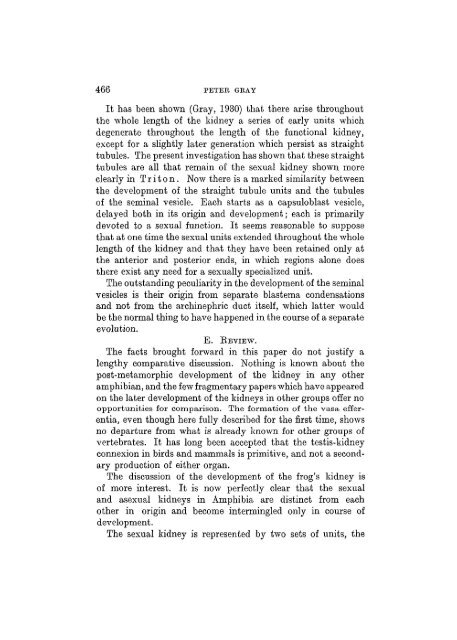ment of the Kidney, and the Development of the - Journal of Cell ...
ment of the Kidney, and the Development of the - Journal of Cell ...
ment of the Kidney, and the Development of the - Journal of Cell ...
You also want an ePaper? Increase the reach of your titles
YUMPU automatically turns print PDFs into web optimized ePapers that Google loves.
466 PETER GRAY<br />
It has been shown (Gray, 1930) that <strong>the</strong>re arise throughout<br />
<strong>the</strong> whole length <strong>of</strong> <strong>the</strong> kidney a series <strong>of</strong> early units which<br />
degenerate throughout <strong>the</strong> length <strong>of</strong> <strong>the</strong> functional kidney,<br />
except for a slightly later generation which persist as straight<br />
tubules. The present investigation has shown that <strong>the</strong>se straight<br />
tubules are all that remain <strong>of</strong> <strong>the</strong> sexual kidney shown more<br />
clearly in Triton. Now <strong>the</strong>re is a marked similarity between<br />
<strong>the</strong> develop<strong>ment</strong> <strong>of</strong> <strong>the</strong> straight tubule units <strong>and</strong> <strong>the</strong> tubules<br />
<strong>of</strong> <strong>the</strong> seminal vesicle. Each starts as a capsuloblast vesicle,<br />
delayed both in its origin <strong>and</strong> develop<strong>ment</strong>; each is primarily<br />
devoted to a sexual function. It seems reasonable to suppose<br />
that at one time <strong>the</strong> sexual units extended throughout <strong>the</strong> whole<br />
length <strong>of</strong> <strong>the</strong> kidney <strong>and</strong> that <strong>the</strong>y have been retained only at<br />
<strong>the</strong> anterior <strong>and</strong> posterior ends, in which regions alone does<br />
<strong>the</strong>re exist any need for a sexually specialized unit.<br />
The outst<strong>and</strong>ing peculiarity in <strong>the</strong> develop<strong>ment</strong> <strong>of</strong> <strong>the</strong> seminal<br />
vesicles is <strong>the</strong>ir origin from separate blastema condensations<br />
<strong>and</strong> not from <strong>the</strong> archinephric duct itself, which latter would<br />
be <strong>the</strong> normal thing to have happened in <strong>the</strong> course <strong>of</strong> a separate<br />
evolution.<br />
E. REVIEW.<br />
The facts brought forward in this paper do not justify a<br />
lengthy comparative discussion. Nothing is known about <strong>the</strong><br />
post-metamorphic develop<strong>ment</strong> <strong>of</strong> <strong>the</strong> kidney in any o<strong>the</strong>r<br />
amphibian, <strong>and</strong> <strong>the</strong> few frag<strong>ment</strong>ary papers which have appeared<br />
on <strong>the</strong> later develop<strong>ment</strong> <strong>of</strong> <strong>the</strong> kidneys in o<strong>the</strong>r groups <strong>of</strong>fer no<br />
opportunities for comparison. The formation <strong>of</strong> <strong>the</strong> vasa efferentia,<br />
even though here fully described for <strong>the</strong> first time, shows<br />
no departure from what is already known for o<strong>the</strong>r groups <strong>of</strong><br />
vertebrates. It has long been accepted that <strong>the</strong> testis-kidney<br />
connexion in birds <strong>and</strong> mammals is primitive, <strong>and</strong> not a secondary<br />
production <strong>of</strong> ei<strong>the</strong>r organ.<br />
The discussion <strong>of</strong> <strong>the</strong> develop<strong>ment</strong> <strong>of</strong> <strong>the</strong> frog's kidney is<br />
<strong>of</strong> more interest. It is now perfectly clear that <strong>the</strong> sexual<br />
<strong>and</strong> asexual kidneys in Amphibia are distinct from each<br />
o<strong>the</strong>r in origin <strong>and</strong> become intermingled only in course <strong>of</strong><br />
develop<strong>ment</strong>.<br />
The sexual kidney is represented by two sets <strong>of</strong> units, <strong>the</strong>
















